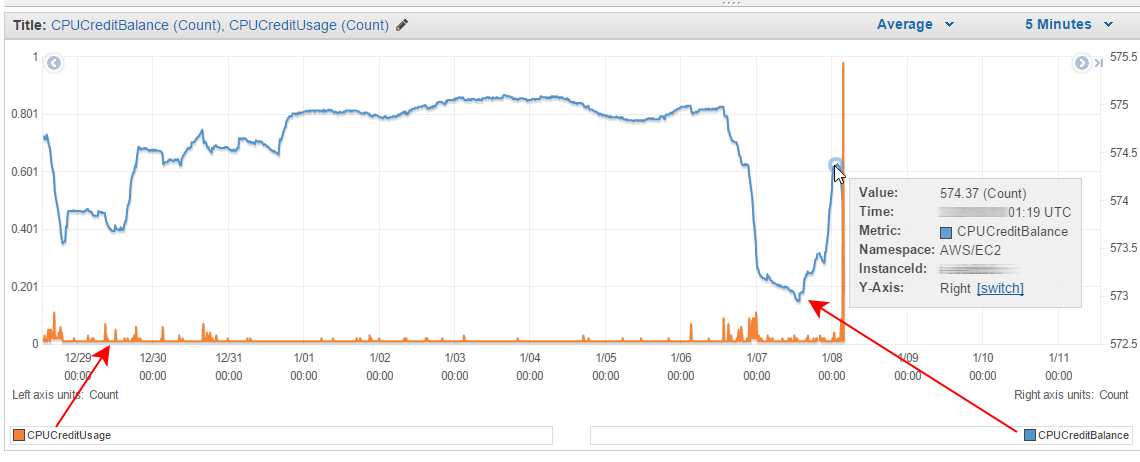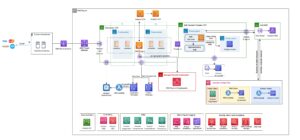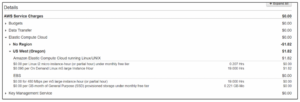CPU credits in AWS are a unit of measurement used to calculate the CPU resources consumed by an Amazon EC2 instance. These credits are accumulated during periods of low CPU usage and can be used during periods of high CPU usage to burst performance.
CPU credits are a way to ensure that your EC2 instances can handle spikes in workloads without incurring additional costs. The more CPU credits an instance has, the longer it can sustain high CPU usage. By understanding and managing CPU credits, you can optimize the performance and cost-effectiveness of your EC2 instances in AWS.

Credit: www.cloudinsidr.com
Introduction To Cpu Credits In Aws
CPU Credits in AWS are a vital resource allocation mechanism that allows users to optimize their instances’ performance efficiently. These credits accumulate during low usage periods and are consumed when the system requires more CPU power, offering a cost-effective and flexible solution for managing workloads.
The Concept Of Cpu Credits
AWS uses CPU Credits to regulate CPU usage on instances. CPU Credits accumulate when underutilized, deplete when overutilized.How Aws Implements Cpu Credits
AWS employs CPU Credits to manage burstable instances. When idle, CPU Credits accumulate, and deplete under load.
Credit: www.cloudinsidr.com
Cpu Credits And T2/t3 Instances
CPU credits play a crucial role in determining the performance of T2 and T3 instances in Amazon Web Services (AWS). Understanding the basics of CPU credits and how they relate to these instance types is vital for optimizing your cloud infrastructure. Let’s delve into the details of CPU credits and their significance in T2 and T3 instances.
Basics Of T2/t3 Instance Types
T2 and T3 instances are cost-effective options for applications that do not require sustained high CPU performance. They are designed to provide a baseline level of CPU performance with the ability to burst above the baseline when additional performance is required. These instances are well-suited for a wide range of workloads, including development environments, small databases, and low-traffic websites.
Cpu Credits: The Currency Of Compute Power
CPU credits serve as the currency of compute power for T2 and T3 instances. These credits are accumulated over time and can be spent to ensure consistent CPU performance when workloads require more power than the baseline performance of the instance. When the instance’s CPU usage remains below the baseline, it earns credits. Conversely, when the usage exceeds the baseline, credits are consumed at a specified rate.
Earning And Consuming Cpu Credits
CPU Credits in AWS are a unit of measure to manage CPU utilization. Instances earn credits during idle time, which are consumed when under load, ensuring consistent performance. Monitoring CPU credit balance is essential for optimal instance performance and cost efficiency in AWS.
Accumulating Cpu Credits
To understand what CPU credits are, we must first understand how they are earned and accumulated. When you launch an Amazon Elastic Compute Cloud (Amazon EC2) instance, it is assigned a baseline CPU performance level that is determined by its instance type. This baseline performance level is measured in the number of CPU credits earned per hour. Each hour, your instance earns CPU credits at the baseline level, regardless of whether it is using the full CPU capacity or not.Cpu Credit Usage Patterns
CPU credits can be consumed when your instance requires more CPU capacity than its baseline performance level. When your instance is idle or running at a low level of CPU utilization, it will accumulate CPU credits that can be used later when the CPU usage spikes. This allows you to burst beyond the baseline performance level for short periods without incurring additional charges. The amount of CPU credits that can be accumulated is capped, and this limit varies by instance type. For example, a t2.micro instance can accumulate up to 144 CPU credits over a 24-hour period, while a t2.xlarge instance can accumulate up to 288 CPU credits over the same period.Example Usage
Let’s say you launch a t2.micro instance with a baseline performance level of 10% CPU utilization and accumulate 144 CPU credits over a 24-hour period. If your instance suddenly requires 100% of its CPU capacity for 30 minutes, it will consume 30 CPU credits. After that, the instance will return to its baseline performance level of 10% CPU utilization and begin accumulating CPU credits again. In conclusion, CPU credits are a flexible and cost-effective way to manage CPU usage on your Amazon EC2 instances. By accumulating credits during periods of low CPU utilization and using them during periods of high CPU utilization, you can optimize your instance’s performance while minimizing costs.Benefits Of Using Cpu Credits
CPU credits in AWS provide a flexible way to manage CPU usage for burstable performance instances. By accumulating credits when usage is low, you can tap into additional CPU power during peak times without interruption. This cost-effective approach ensures smooth performance for your applications without the need for constant monitoring or adjustments.
Cost-effectiveness For Variable Workloads
CPU credits in AWS are a way to measure and allocate CPU usage in a cost-effective manner. With CPU credits, AWS can provide users with a flexible and cost-efficient way to handle workloads that vary in their CPU usage patterns. CPU credits are accrued when your workload is running below the baseline level, and then used when your workload requires more CPU resources than the baseline level. This means that you only pay for the extra CPU resources that your workload needs, and don’t pay for unused resources. Using CPU credits can be especially beneficial for workloads that have variable usage patterns, such as web servers or applications that experience fluctuations in traffic throughout the day. With CPU credits, you can be sure that you have access to the CPU resources you need when you need them, without paying for more resources than you need during periods of low usage.Enhanced Performance During Spikes
Another benefit of using CPU credits in AWS is the ability to handle spikes in CPU usage without incurring additional costs. When your workload experiences a spike in CPU usage, AWS automatically uses your accrued CPU credits to handle the increased demand. This means that your workload can handle sudden increases in demand without incurring additional costs, and without the need for manual intervention. In addition, CPU credits can help to improve the overall performance of your workload during periods of high demand. With CPU credits, your workload can quickly and easily access additional CPU resources as needed, without the need to manually provision additional resources. This can help to ensure that your workload is able to handle spikes in demand quickly and efficiently, without impacting performance or incurring additional costs. In conclusion, CPU credits in AWS provide a flexible and cost-effective way to handle variable workloads and spikes in CPU usage. By using CPU credits, you can ensure that your workload has access to the CPU resources it needs, when it needs them, without incurring unnecessary costs.Monitoring Cpu Credit Balance
When using AWS EC2 instances, it is important to keep track of the CPU credit balance to ensure optimal performance and cost management. CPU credits are a metric used by Amazon Web Services (AWS) to measure the CPU utilization of burstable instances. These instances accrue CPU credits when they operate below their baseline performance and consume them when they need to burst above the baseline.
Tools For Cpu Credit Tracking
Monitoring your CPU credit balance is crucial to prevent performance degradation and unexpected costs. AWS provides several tools to help you track and manage your CPU credits effectively:
- CloudWatch: AWS CloudWatch is a monitoring service that allows you to collect and track metrics, including CPU credits, for your EC2 instances. It provides valuable insights into your CPU utilization and helps you make informed decisions.
- CloudWatch Alarms: You can set up CloudWatch alarms to notify you when your CPU credit balance drops below a certain threshold. This proactive approach ensures that you can take action before experiencing performance issues.
- CloudWatch Events: With CloudWatch Events, you can automate actions based on specific events. For example, you can trigger an event to increase the CPU credit balance when it reaches a critical level.
Interpreting Cloudwatch Metrics
CloudWatch provides various metrics related to CPU credits that help you understand and analyze your instance’s performance. Some important metrics to consider include:
- CPU Credit Usage: This metric indicates the number of CPU credits consumed by your instance. Monitoring this metric allows you to track your usage patterns and identify any unusual spikes or consistent high utilization.
- CPU Credit Balance: The CPU credit balance metric shows the number of unused CPU credits available to your instance. It is essential to keep an eye on this metric to ensure that you have sufficient credits for bursts in CPU utilization.
- CPU Utilization: Although not directly related to CPU credits, monitoring CPU utilization can provide insights into how your instance is performing. High CPU utilization combined with a low credit balance may indicate the need to upgrade to a more powerful instance type.
By regularly monitoring and interpreting these CloudWatch metrics, you can effectively manage your CPU credit balance and optimize the performance and cost efficiency of your EC2 instances.
Cpu Credits For Sustained Performance
AWS provides a unique feature known as CPU credits, which plays a crucial role in optimizing the performance of instances. CPU credits are designed to offer sustained performance for burstable workloads by managing the CPU utilization of instances. This blog post will delve into the concept of CPU credits, with a focus on sustaining performance and strategies for effective CPU credit management.
Maintaining Performance With Cpu Credits
CPU credits are essential for maintaining the performance of AWS instances, especially for burstable workloads. When instances require more processing power than their baseline level, they consume CPU credits to meet the increased demand. As a result, CPU credits play a vital role in preventing performance degradation during sudden spikes in workload.
Strategies For Cpu Credit Management
Effective management of CPU credits is crucial for optimizing the performance of AWS instances. By implementing strategic approaches, users can efficiently utilize and monitor CPU credits to ensure consistent and reliable performance. Strategies may include monitoring CPU credit balance, optimizing workload scheduling, and leveraging instance types that align with workload requirements.
Best Practices For Cpu Credit Usage
CPU credits in AWS are a crucial resource for managing compute workloads effectively. By following best practices for CPU credit usage, you can optimize performance and cost efficiency. Ensure you understand how CPU credits work, monitor credit balances, scale instances wisely, and leverage burstable instances to maximize your AWS resources.
CPU Credits in AWS are crucial for managing EC2 instances efficiently. By following best practices, you can optimize your workloads for CPU credit efficiency and avoid depletion.
Optimizing Workloads For Cpu Credit Efficiency
- Monitor CPU credit balance regularly.
- Use burstable instance types judiciously.
- Implement auto-scaling to handle demand spikes.
Avoiding Cpu Credit Depletion
- Avoid running CPU-intensive applications constantly.
- Consider switching to fixed performance instances when necessary.
- Optimize applications for lower CPU utilization where possible.
Comparing Cpu Credit Models Across Cloud Providers
Compare CPU credit models across various cloud providers to make informed decisions about your cloud infrastructure. In AWS, CPU credits are a way to measure CPU usage and can be used for burstable instances. Understanding the differences in credit models can help optimize costs and performance.
Aws Cpu Credits Vs. Other Cloud Solutions
When comparing CPU credit models across cloud providers, it’s essential to understand the nuances of AWS CPU credits. AWS uses CPU credits as a way to manage CPU utilization for burstable instances. This system allows instances to burst beyond their baseline performance level when needed, using accrued CPU credits during peak usage.Choosing The Right Provider For Your Needs
AWS provides flexibility with its CPU credit system, allowing users to optimize performance and costs based on their workload requirements. Other cloud providers may offer similar models, but it’s crucial to evaluate each provider’s CPU credit system to ensure it aligns with your specific use case and budget.
Credit: www.concurrencylabs.com
Frequently Asked Questions
What Is A Cpu Credit?
A CPU credit is a way for cloud computing services to measure and charge for CPU usage. Each credit represents a certain amount of CPU usage over a set period of time. When a virtual machine uses CPU resources, it consumes CPU credits, which are then replenished over time.
This allows for more efficient and cost-effective use of cloud computing resources.
What Happens When Cpu Credits Run Out?
When CPU credits run out, your application’s performance may be limited until new credits accrue. It’s crucial to monitor and manage CPU usage to avoid disruptions.
What Is Cpu Credit Balance In Aws Rds?
CPU credit balance in AWS RDS is a metric that tracks available CPU credits for burstable instances.
What Is Compute Credits?
Compute credits are a unit used to measure the amount of computational resources consumed. They help track and manage usage in cloud computing. By using compute credits, users can optimize resource allocation and control costs efficiently.
Conclusion
CPU credits in AWS are a valuable resource for managing burstable workloads efficiently. By understanding how CPU credits work, you can optimize your usage and minimize costs. With careful monitoring and management, you can make the most of your CPU credits and ensure smooth performance for your AWS workloads.






